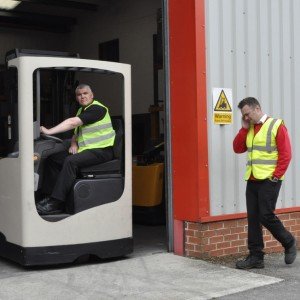Mentor Training Managing Director Stuart Taylor discusses behavioural training and how it’s transforming attitudes to lift truck safety.
Health and safety can sometimes be seen as annoying bureaucracy, but there’s no getting away from it: lift truck accidents can and often do result in life-changing, devastating consequences.
There are thousands of accidents involving lift trucks each year and for no-one is this risk greater than those working alongside the trucks as, according to HSE figures, pedestrians account for 57% of those injured in lift truck accidents.
It is clear there is still a great deal of work to be done. But for non-operators to truly work safely, they must be able to recognise the dangers associated with lift truck operations; understand what this means for them and, most importantly, know how to respond appropriately.

Complacency creep
But, the often routine and repetitive nature of their work means that – even when workers are informed – it is easy for bad habits to creep in. And this is true whether you’re working alongside the truck or actually driving it.
Why? Because we calculate risk based on what has – or hasn’t – happened previously – even when we know we shouldn’t. When ‘nothing bad happened last time’, we relax and become complacent.
And once this happens, you have a workplace where dangerous and risky behaviour becomes the norm. But it doesn’t need to be this way. By addressing workers’ behaviours and changing attitudes, you can foster a workforce that adopts and, more importantly, encourages and enforces best practice.
Taking ownership
This is the thinking behind our latest course: Safely Working With Lift Trucks. Rather than force workers to adhere to a company’s policy through threat of disciplinary action, it clearly communicates the real-world benefits of taking ownership of your safety… and others.
So what does being safe mean for you? It means coming home to the people you love and doing the things you enjoy. So we closely link these benefits with adopting best practice. After all, you are less likely to take unnecessary risks if you aware of what those risks mean to you as an individual. And because you’ve embraced it on a personal level, it means you’ll do the right thing because you want to – not because you’re being forced to…
Creating a shared attitude to safety
This ownership of safety – to be successful in the long-term – needs to extend beyond the individual to operate a safe site.
Peer group pressure is immensely powerful, so one of the most important steps to reducing risk on site is by nurturing a positive safety culture: a shared belief about risk, hazards and accidents. The aim? To establish a self-policing environment where bad practice is not accepted by the community.
This is by no means a new concept. Take driving for example. When bad habits creep in, we are held to account – by cameras and by police – but no more so than by our peers. So it follows that we encourage the same in lift truck operations.
It makes sense, therefore, that every single employee on site receives short, sharp and though-provoking training on the dangers posed by lift trucks – and how to avoid them.
Our two-hour course, which has been trialled at sites across the UK since December, has proved to be an exceptionally cost effective way of delivering high-impact, low-cost training to those working on or around lift trucks, that both informs the unaware and refocuses the experienced who may have fallen into bad habits.
Changing attitudes and behaviour is big step towards driving down risk on site, but it’s important to remember that establishing and maintaining a safe site relies on taking a holistic approach. From your equipment and sites to your operators and management, it’s important to look at safety from every angle.
Stuart Taylor is Managing Director at Mentor Training.
To find out more about Mentor’s range of products and services, visit www.mentortraining.co.uk or call 01246 555222.
Approaches to managing the risks associated Musculoskeletal disorders
In this episode of the Safety & Health Podcast, we hear from Matt Birtles, Principal Ergonomics Consultant at HSE’s Science and Research Centre, about the different approaches to managing the risks associated with Musculoskeletal disorders.
Matt, an ergonomics and human factors expert, shares his thoughts on why MSDs are important, the various prevalent rates across the UK, what you can do within your own organisation and the Risk Management process surrounding MSD’s.


